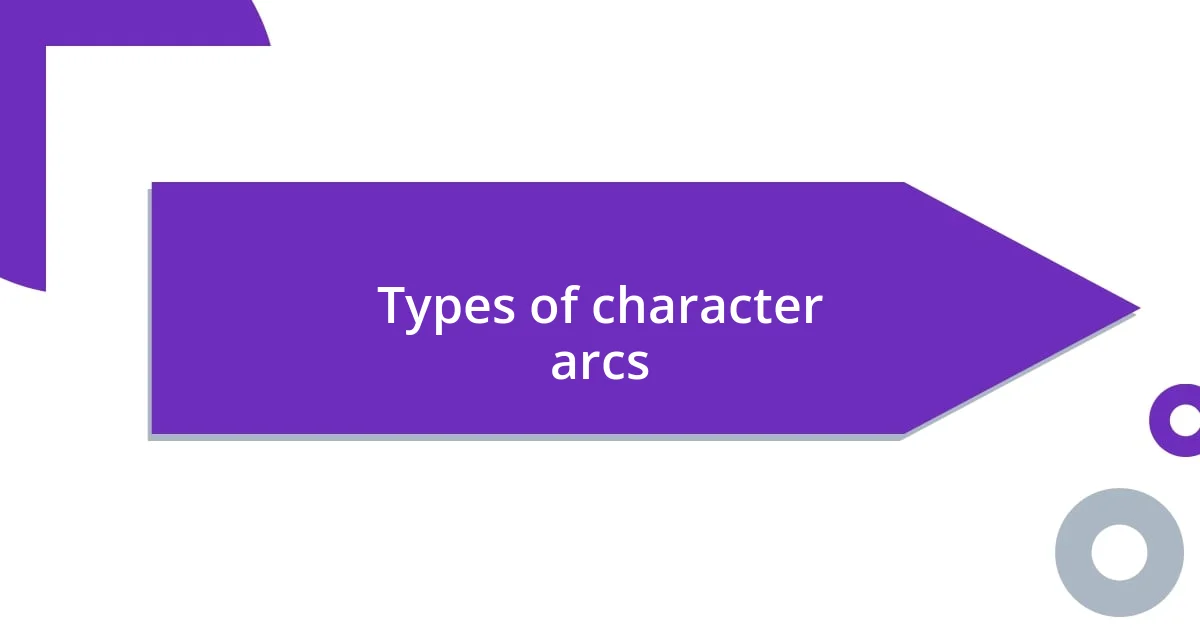Key takeaways:
- Character arcs reflect emotional journeys that enable readers to connect deeply with characters, showcasing transformation, growth, or decline.
- Effective character development involves clear motivations, internal and external conflicts, and relationships that shape a character’s evolution.
- Common pitfalls in character arcs include neglecting consistency, rushing character development, and overlooking internal conflict, which can diminish the story’s impact.

Understanding character arcs
Character arcs are the emotional journeys that a character undergoes throughout a story. I’ve always found it fascinating how these arcs mirror our own life changes; they help us relate to characters on a deeper level. Have you ever felt like a character was going through exactly what you were? That connection is really powerful.
A well-structured character arc typically involves transformation, whether it’s growth, decline, or redemption. Think about a time when you faced adversity and came out stronger on the other side. That personal evolution is what makes us cheer for characters like Katniss Everdeen or hold our breath for those on a darker path, such as Walter White. It’s amazing how a single event can shift a character’s perspective and drive their actions moving forward.
Understanding these arcs can illuminate the motivations behind a character’s choices. I remember my first experience writing a story where my protagonist started off selfish but, through various challenges, learned empathy. That journey felt incredibly authentic—not just for the character, but for me as a writer. When we grasp the essence of character arcs, we allow ourselves to write stories that resonate emotionally and feel true to the complexities of human experience.

Importance of character development
Character development is crucial because it transforms a flat character into a relatable individual. When I think of my favorite stories, those characters often have rich backstories and face challenges that change them. This evolution not only keeps me invested but also allows for deeper emotional connections, almost like leaning on someone who grows alongside me.
Without strong character development, stories can feel hollow. I recall working on a novel where my antagonist seemed one-dimensional at first. It wasn’t until I explored their backstory and motives that they became fully realized. This rich development turned what was a simple villain into a complex character whose decisions I could empathize with, entirely changing the story’s dynamic.
Moreover, character arcs invite readers to reflect on their own growth. I’ve noticed that when characters confront their flaws and evolve, readers often find themselves thinking about their own lives. This introspection can spark conversations about personal choices and moral dilemmas, making the narrative an engaging experience that extends beyond the page.
| Aspect | Impact |
|---|---|
| Relatability | Engages audience on an emotional level |
| Complexity | Rich narratives that reflect human experiences |
| Growth | Encourages readers to reflect on their own journeys |

Key elements of effective arcs
Character arcs are driven by a few essential elements that can truly elevate a story. From my experience, one key component is a clear motivation. When a character has a strong desire or goal, it propels them through the narrative, creating tension and curiosity. For instance, I remember crafting a protagonist who was fiercely protective of their family. This protective instinct defined their choices and ultimately led to significant growth.
Another critical aspect is the presence of conflict, both internal and external. I’ve often found that the most memorable character journeys stem from the struggles a character faces. They can come from personal dilemmas or society’s challenges, and watching a character navigate these trials makes the experience all the more compelling.
Key elements of effective arcs include:
- Motivation: A clear goal or desire that drives character actions.
- Conflict: The challenges and struggles that push the character to evolve.
- Support and Relationships: Interactions with other characters that shape growth.
I recall writing a story where my main character’s relationships were pivotal in their transformation. Their friends and family challenged their beliefs, which ultimately forced them to confront their fears and grow. That realization—that relationships can fuel change—has stayed with me and influenced how I develop characters in my work.

Types of character arcs
When I think about the various types of character arcs, a few notable examples come to mind. The classic “transformation arc” is particularly intriguing to me. This is where a character undergoes a significant internal change that profoundly alters their worldview. I once crafted a character who started off as a cynical detective, dismissing kindness as a weakness. Throughout the story, the challenges he faced forced him to reassess his beliefs, leading to a powerful transformation that resonated with readers. Have you ever seen a character change before your eyes and thought about how it reflects our own capacity to grow?
Another compelling type is the “fall arc,” which can be incredibly gripping. This arc depicts a character who, initially strong and admirable, succumbs to their flaws or outside pressures, leading to their downfall. I remember writing about a charismatic leader whose unchecked ambition led to a personal and professional collapse. It was challenging, yet rewarding to explore their descent; it provoked feelings of empathy and caution in me. Don’t you find it fascinating how these arcs showcase vulnerabilities that we all share?
Lastly, I appreciate the “static arc,” where a character remains essentially unchanged but influences others around them. These characters often serve as anchors or catalysts for change in other characters’ arcs. I once designed a wise mentor who, despite their own challenges, helped guide younger characters through their struggles. Seeing their steady presence brought a sense of balance to the narrative and reminded me how sometimes, it’s not only about the change we experience but also about the support we offer others. Have you ever identified with a character who, while not changing themselves, inspired others to do so?

Crafting a compelling journey
Crafting a compelling journey requires an intimate understanding of a character’s inner world. I’ve always believed that defining moments contribute to growth—the kind of moments that challenge what a character thought they knew about themselves. I recall a story where my protagonist faced a moral quandary, forcing her to choose between loyalty and her principles. That decisive choice propelled her into a deeper exploration of her identity, showcasing how powerful those seemingly small moments can be.
In my experience, the journey isn’t just about what happens to the character; it’s about how they respond to their experiences. I once wrote about a character who lost everything in a tragic accident. Instead of spiraling into despair, she gradually uncovered a resilience she never knew she possessed. This arc taught me that sometimes the most gripping transformations stem from how characters confront their pain. What do you think? Isn’t it captivating to see someone rise from their ashes?
Ultimately, I’ve found that integrating authentic emotional stakes can elevate a character’s journey. For instance, developing a subplot where my character reconnects with a long-lost sibling added layers of complexity to her quest. The emotional turmoil and eventual reconciliation made her journey resonate on a deeper level. Have you ever encountered a narrative where these emotional threads made all the difference? I believe they do; they turn a good story into an unforgettable one.

Common pitfalls to avoid
When crafting character arcs, one pitfall I encounter often is neglecting character consistency. I’ve learned that characters must behave in ways that align with their established traits. In a story I developed, I had a character who started as a fiercely independent individual yet suddenly relied on others without proper justification. This inconsistency didn’t just confuse readers; it undermined the integrity of the character’s journey. Have you ever read a story where a character’s actions felt out of place? It can really diminish the impact of their arc.
Another common mistake is failing to allow characters the space to grow naturally. For instance, I once rushed a character’s development to fit a plot twist, which ended up feeling forced and unbelievable. Instead of a gradual transition, the character’s change appeared abrupt, leaving readers feeling disconnected. This experience taught me the importance of pacing—sometimes, allowing characters to evolve at their own rhythm is what truly deepens their story. Have you noticed how a well-paced arc can draw you in?
Lastly, overlooking the significance of internal conflict can derail an arc entirely. I vividly remember writing a character who faced external challenges, but I didn’t delve deeply enough into their inner struggles. The result? Readers didn’t fully connect with the character’s journey, missing out on the emotional heft that internal conflict can provide. It’s fascinating to see how grappling with one’s inner demons can lead to profound growth and relatability. Have you felt that connection when characters wrestle with their own flaws? It’s this struggle that often resonates most with us.

Tips for successful execution
One of my key tips for successfully executing character arcs is to embrace the power of feedback. Early in my writing journey, I was hesitant to share my drafts, fearing criticism. However, when I finally gathered a group of trusted readers, their insights highlighted aspects I hadn’t considered, like my character’s motivations and how they could be portrayed more authentically. Have you ever been surprised by what others see in your work? It’s eye-opening to realize how collaborative feedback can illuminate paths I hadn’t thought existed.
Another approach I’ve found invaluable is to map out a character’s emotional journey before diving into the plot. I once jotted down my protagonist’s emotional landscape in a visual format, mapping out highs, lows, and pivotal turning points. This simple exercise not only provided clarity but also revealed potential plot holes or areas needing deeper exploration. Isn’t it fascinating how a visual representation can unlock a deeper understanding of your character? Taking time to map emotions ensures that every scene pulls weight in the overall story arc.
Lastly, I’ve learned the importance of allowing my characters to be messy. During one of my writing experiments, I created a character who made poor choices, which initially frustrated me. But as I leaned into her flaws, I realized those imperfections made her relatable and real. Readers often connect with characters through their failures and struggles rather than their successes. Have you noticed how a flawed character often resonates more strongly? That’s the beauty of a well-executed character arc—it reflects the complexity of human nature itself.














